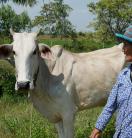New Fodder options shared in Cambodia, Laos
An ACIAR-supported project is helping smallholder farmers in Cambodia and Laos diversify their farming operations to become more resilient and profitable by introducing new fodder species.
Traditionally, farming livelihoods in the region depend on subsistence rainfed rice crops and open grazing of livestock.
However, with poor, unproductive, sandy soils and limited access to fertilisers, irrigation water, labour and quality seed and planting materials, increasing farm productivity remains a significant barrier for these rural communities, with many living below the poverty line.
Over the next three years, the project will introduce new forage and fodder species to farming systems, helping farmers intensify production on their land and integrate crop and livestock systems while protecting their soils.
ACIAR Research Program Manager for Soil and Land Management, Dr James Quilty, said the new fodder options will help boost farmers’ opportunities to have livestock, which could be vital to improving livelihoods.
Dr Quilty said livestock is a significant asset for smallholder farmers across many developing nations, including Laos and Cambodia’s low input rice-based cropping systems.
‘More and better-quality feed can improve the health and productivity of livestock, and therefore the incomes of the smallholder farmers,’ Dr Quilty said.
The project's first phase, which finished in March 2021, demonstrated that growing fodder crops after the wet season rice crop increased feed availability in the dry season.
‘The second phase of the project aims to translate what we found into useable, practical information for farmers that they can easily apply to the management of their fodder crops.’
The project will recommend what fodder species farmers should use and where they should be planted based on each farm’s soil landscape. The project team will also aim to overcome the barriers facing farmers in adopting fodder and forage plants, including changes to policy and supply chains.
Associate Professor Matthew Denton, from The University of Adelaide’s School of Agriculture, Food and Wine, is excited to continue leading the research initiative into its second phase.
‘Through this project, we are building expertise in forages among stakeholders and scaling out new technologies to leave a legacy for adoption in the region,’ Associate Professor Denton said.
‘We anticipate this will assist in reducing poverty for smallholder farmers.’
He said the project team will initially concentrate on developing innovative ways to maintain engagement and develop capacity safely during the COVID-19 pandemic.
‘We’re looking forward to building opportunities with our project partners.’
Dr Chhay Ty is Deputy Director of the Centre for Livestock and Agriculture Development (CelAgrid) in Cambodia. He and his team have been instrumental in the project activities involving farmers in Cambodia.
He said the project would help Cambodian smallholder farmers gain more knowledge on crops, especially grass planting, to improve cattle production and income.
Dr Phonepaseuth Phengsavanh, Director of the National Agriculture and Forestry Research Institute (NAFRI) Livestock Research Centre in Laos, said the project would help build capacity for NAFRI staff.
‘I will be excited to learn about new research outcomes that will be produced during this project, particularly the suitable rate of fertilisers on sandy soil in Lao PDR,’ Dr Pengsavanh said.
He also said he’s interested in learning about new approaches to scaling out the forage technologies to farmers.
The key partners are Cambodia Agricultural Research and Development Institute, Royal University of Agriculture, National Agriculture and Forestry Research Institute, and Centre for Livestock and Agriculture Development (CeLAgrid). With the second phase, the project also welcomes the partnership of National University of Laos and General Directorate of Animal Health and Production.
The project, Management practices for profitable crop livestock systems for Cambodia and Lao PDR, is funded through the ACIAR Soil and Land Management Research Program and is scheduled to run until 2024. Learn more about the project.



